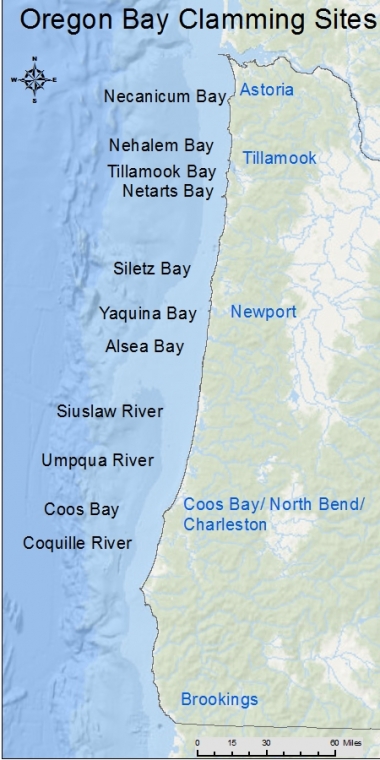
Where to bay clam in Oregon
In nearly every Oregon estuary, some species of bay clams can be found. However, abundances and variety of species is different for each bay depending on a number of factors. Size and shape of the bay are the most critical factors.
Tidal exchange, salinity, species ranges, and substrates also weigh heavily.

This map outlines areas that are most commonly accessed by recreational diggers. Before heading out, be sure to have your shellfish license, a copy of the regulations (either paper or online), and check the tides.
For your safety, call the Oregon Department of Agriculture Shellfish Safety Hotline before harvesting any shellfish at 1-800-448-2474 or check their website.
Go to our How to bay clam and How to razor clam articles to learn digging techniques that will increase your chances of success!
Summary of bay clam availability by area:
- Necanicum Bay: softshells, purple varnish
- Nehalem Bay: softshells, purple varnish
- Tillamook Bay: gapers, butters, cockles, littlenecks, softshells, purple varnish
- Netarts Bay: gapers, butters, cockles, littlenecks, softshells, purple varnish
- Nestucca Bay: softshells, purple varnish
- Siletz Bay: softshells, purple varnish
- Yaquina Bay: gapers, butters, cockles, littlenecks, softshells, purple varnish
- Alsea Bay: cockles, softshells, purple varnish
- Siuslaw River: gapers, cockles, softshells
- Umpqua River: gapers, softshells
- Coos Bay: gapers, butters, cockles, littlenecks, softshells
- Coquille River: softshells
- Chetco and Rogue River basins have high freshwater influence, and therefore no accessible bay clams. In some of the south coast's rocky nearshore areas, littleneck and butter clams can be found under rocks and amongst gravel. Due to the tough terrain, very few clammers harvest on the rocky nearshore of the south coast.
Header photo by Max Ray, Creative Commons


